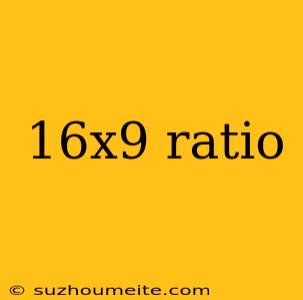Understanding the 16:9 Aspect Ratio
The 16:9 aspect ratio is a widely used standard in modern technology, particularly in digital displays and media. But what exactly does it mean, and how does it impact our viewing experience?
What is the 16:9 Aspect Ratio?
The 16:9 aspect ratio refers to the proportion of an image or video's width to its height. In this case, the width is 16 units, and the height is 9 units. This means that for every 16 pixels of width, there are 9 pixels of height. This ratio is commonly used in high-definition television (HDTV), digital cinema, and computer monitors.
History of the 16:9 Aspect Ratio
The 16:9 aspect ratio was first introduced in the 1980s as a compromise between the traditional 4:3 aspect ratio used in older TVs and the wider formats used in cinemas. The goal was to create a format that could accommodate both the traditional TV format and the wider cinematic format. The 16:9 ratio was officially adopted as the standard for HDTV in 1996.
Advantages of the 16:9 Aspect Ratio
Wider Screen
The 16:9 aspect ratio provides a wider screen than the traditional 4:3 ratio, allowing for a more immersive viewing experience. This is particularly noticeable when watching movies or playing video games.
Better-suited for Modern Content
The 16:9 ratio is better-suited for modern content, which is often produced in widescreen formats. This means that viewers can enjoy a more cinematic experience when watching movies or TV shows.
Improved Multitasking
The wider screen of the 16:9 ratio makes it easier to multitask, as users can have multiple windows or applications open at the same time.
Disadvantages of the 16:9 Aspect Ratio
Letterboxing
When watching older content produced in the 4:3 ratio, black bars will appear at the top and bottom of the screen to fill the void. This is known as letterboxing.
Not Ideal for Vertical Content
The 16:9 ratio is not well-suited for vertical content, such as social media apps or web browsing. This can lead to a less-than-ideal viewing experience.
Conclusion
The 16:9 aspect ratio has revolutionized the way we consume media, providing a wider and more immersive viewing experience. While it has its disadvantages, the benefits of the 16:9 ratio far outweigh the drawbacks. As technology continues to evolve, it's likely that the 16:9 ratio will remain a standard in digital displays and media.
